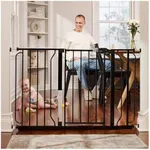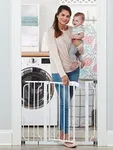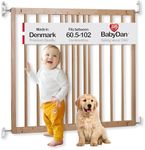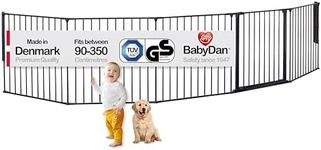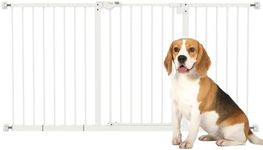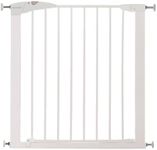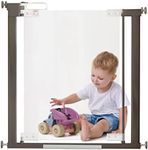Buying Guide for the Best Baby Gates
Choosing the right baby gate is crucial for ensuring the safety of your little one. Baby gates help to create a secure environment by blocking off areas that may be hazardous, such as stairs or kitchens. When selecting a baby gate, it's important to consider various factors to ensure it meets your specific needs and provides the best protection for your child.Type of GateThere are two main types of baby gates: pressure-mounted and hardware-mounted. Pressure-mounted gates are easy to install and move, making them ideal for temporary use or areas where you don't want to drill holes. However, they are not as secure as hardware-mounted gates, which are screwed into the wall and are better for high-risk areas like the top of stairs. Choose a pressure-mounted gate for flexibility and ease of use, and a hardware-mounted gate for maximum security.
HeightThe height of the baby gate is important to prevent your child from climbing over it. Standard baby gates are usually around 30 inches tall, which is sufficient for most toddlers. If you have a particularly adventurous child or a pet that you also want to keep contained, you might consider a taller gate, around 36 inches or more. Assess your child's climbing abilities and choose a height that will effectively keep them safe.
Width AdjustabilityBaby gates come in various widths and some are adjustable to fit different openings. Measure the width of the area where you plan to install the gate and ensure the gate you choose can accommodate that space. Some gates come with extensions to fit wider openings. If you have an unusually wide or narrow space, look for a gate that offers the necessary adjustability.
MaterialBaby gates are typically made from metal, wood, or plastic. Metal gates are very durable and secure, making them a good choice for high-traffic areas. Wooden gates can be more aesthetically pleasing and blend in with home decor, but they may not be as sturdy as metal. Plastic gates are lightweight and easy to move, but they may not offer the same level of security. Consider where the gate will be used and choose a material that balances durability with your aesthetic preferences.
Ease of UseA baby gate should be easy for adults to open and close, but difficult for children. Look for gates with one-handed operation, which allows you to open the gate while holding your child. Some gates have a foot pedal for hands-free opening. Test the mechanism to ensure it is convenient for you but secure enough to prevent your child from figuring it out. Choose a gate that offers a good balance between ease of use for adults and security for children.
Safety StandardsEnsure the baby gate meets safety standards set by organizations such as the Juvenile Products Manufacturers Association (JPMA). These standards ensure the gate has been tested for safety and durability. Look for certification labels or check the manufacturer's information to confirm compliance. Choosing a gate that meets these standards provides peace of mind that it has been rigorously tested for your child's safety.
